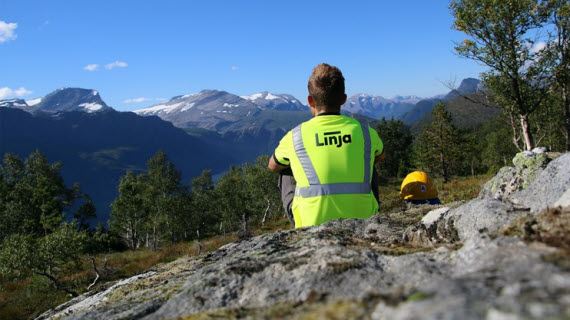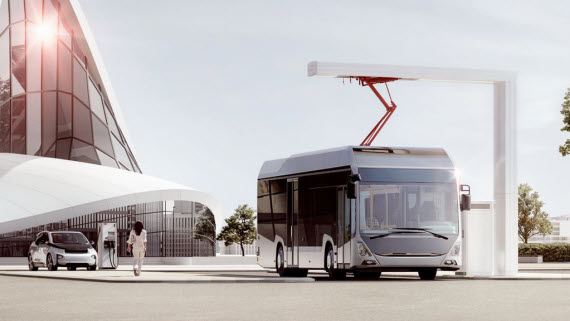Four years have passed since the first seeds of CINELDI, one of the world's largest research centre on Smart Grids, were sowed. The centre's work is only half complete, but we are already seeing the first fruits.
A flexible and robust electricity grid
The electricity distribution grid must adapt to the ever-changing ways we generate and use energy. To cope with these changes and the increased demand, better solutions have to be developed across many facets. Since day one, CINELDI’s vision has been clear: To enable a cost-efficient realization of the future flexible and robust electricity grid. Due to the ongoing electrification of society, Norwegian grid companies must balance an aging grid with an increasing demand for power, changing consumption patterns and the introduction of solar and wind energy. Solar and wind puts strains on the grid which it was not designed for. The grid is in dire need of innovative new methodologies and technologies, but no one company can come up with the best solutions on their own. Working together within CINELDI, Norway’s leading power grid companies, technology providers and research institutions, power market operators, system operators, member organizations and Norwegian authorities develop innovative knowledge and research results for the Centre's partners and the industry in general. All Smart Grid research projects create results and knowledge, so what is it about CINELDI that makes it so unique? We asked the partners.

When bigger is better
The broad nature of partner categories, high number of partners in each category and the Centre's duration are key factors pointed out by most partners when asked what makes membership in CINELDI so valuable.
- Being part of a collaborative effort like CINELDI, where representatives from the entire industry are gathered, makes a lot of sense. It gives us an opportunity to see problems and solutions from all angles, says Tarjei Solvang from Nordlandsnett.
- Through CINELDI we can collaborate with our largest and most important customers in Norway. We can also test solutions that would be difficult to do otherwise, because we have access to greater resources. It reinforces our position in Norway, says ABB Electrification's Stian Reite.
- What makes CINELDI unique compared to shorter projects with fewer partners is the Centre's ability to see and work on the whole picture. Each work package is like a piece of Lego; It takes all of us to build the future grid, says Inger Lundetræ from BKK Nett.
Grid companies’ technological needs in 2040, or 2030 for that matter, will be completely different to 2020. That means technology providers must already “predict” which technologies their customers will demand in the future.
- The investments we do and what we create will have an incredibly long lifespan, so it means a lot to us to make the right choices now. We will live with those choices for many years to come, says Sigurd Kvistad from Elvia. Having both "supplier and customer" under one roof is therefore a huge advantage.

- The strong representation of grid companies in the consortium, together with science and technology partners, ensures that our challenges serve as a basis for research and technology development. It connects the industries's future needs and future solutions in a unique way compared to smaller projects, says Nordlandsnett's Solvang. Stian Reite from ABB Electrification, agrees.
We are completely dependent on having close contact with the market to develop the right solutions. But there aren't many arenas where we can sit down with our customers and discuss new functionalities. CINELDI has created an arena where we as technology providers can do just that, he says.
- This is also valuable for the grid companies, he adds.
- The Centre gives us the advantage of working with many grid companies in a coordinated manner. This way we can get input from several at a time, which lowers our risk of failure when innovating. That ensures the science is more relevant and we can develop more relevant solutions because of it, Rolf Pedersen from Aidon explains.
Aidon’s main products are AMR solutions and services. Pedersen also points out that CINELDI does not only grant access to a large consortium, participation in the centre also grants access to world class research infrastructure and research scientists at the same time.
- The quality and speed of innovation is increased because of facilities like the National Smart Grid Laboratory. Here, we can test AMR innovations and new solutions more precisely and faster than in the live-grid. This not only creates value for us as a technology provider. It gives grid companies better and faster return on their AMR investment.
When the sum is greater than the individual parts
The sharing of experiences and results between companies that would otherwise consider each other competitors is one of CINELDI’s big wins according to the partners, because everyone doesn’t have to do the same pilot projects or the same research.
- Access to knowledge is a tool for development but it does not in itself define our success as a grid company. How we implement and use the knowledge is what will define our success, says Solvang from Nordlandsnett.
Kvistad from Elvia sees great benefits to more people being able to share and have access to the same knowledge through CINELDI.
- Norway is a small country, so the fact that we cooperate and get an overview of each other's pilot projects, is very good. Even if we gain access to the same knowledge, what sets us apart is how we apply the knowledge. I think we all grow from sharing knowledge. It lifts the whole industry. In relation to the challenges that lie ahead, we are dependent on elevating knowledge levels.
For Sven Arild Kjerpeset, from the grid company Linja, CINELDI's big consortium acts as an incentive to stretch further.

- The involvement in CINELDI creates a kind of incentive. We enter with certain obligations to the other partners and there is a pride in meeting these obligations. We end up stretching a little further when testing things, than we would otherwise, he says.
It feels safer to start a project when you have someone to confer and run a dialogue with. It creates a safe environment for throwing yourself into the unknown. By being a part of CINELDI we have been given opportunities we would not else have had. For example, our pilot project cooperation with NODES, he continues.
NODES is a new marketplace for local flexibility, providing insight and support to projects like CINELDI where all stakeholders can develop their knowledge and increase their understanding of local flexibility markets.
– Both NODES and grid companies have a mutual need to develop their knowledge on how flexibility data needs to be captured and managed so that it can be used to provide transparency. E.g. who owns the flexibility, can it be made commercially available and at which price will a transaction happen? Gaining and sharing this is easier through CINELDI, says Hallstein Hagen from NODES.
Reaping the first fruits
Up until now, CINELDI has documented almost 50 (partial) results and 14 innovations have been identified. One in particular stands out from the pack having already been implemented by several partners: The scenarios.
- CINELDI prepares us for the future. Digitalisation is disrupting the power-industry and it's demanding to navigate an unmapped future, says Linja's Kjerpeset No one can know exactly what the future looks like, but there are ways to dissect what the most likely paths are. To map possible future directions the power grid industry may take, CINELDI have developed about 100 mini-scenarios. I.e. different ways the grid can develop over the next two decades, depending on factors like societal trends and values, politics, and technology development.
To make the scenarios more tangible, they are clustered into four main scenarios. These scenarios provide insights on knowledge and technology gaps science and industry must fill. They have been used to direct the Centre’s research and they have been adopted by several of the partners for strategic planning.
- When I talk about CINELDI to others I tend to fall back on the scenario-work we did. The scenarios gave us a clear picture of the driving forces affecting smart grid development and where the industry is headed. That is a picture we did not have earlier, Kjerpeset from Linja continues.
- The scenario-work we did in the work packages gave us a very clear picture of what is likely to happen over the next couple of decades. When you have an idea of that, you can start working on strategies, Rolf Pedersen from Aidon explains.
A place to sow and grow new ideas
R&D is typically done between a limited number of industry partners and with a limited, specific research agenda. CINELDI is in many ways the opposite; many partners with a much broader goal, i.e. enabling the future smart electricity grid. That opens new doors for the partners and the science.
- It has given us good opportunities to create pilot projects and to test new technology, without too much bureaucracy. Within the R&D scheme, one must go through an application process and satisfy a number of criteria. But in CINELDI you already have these funds available, making it easier to try out new technology and carry out pilot projects, Kvistad from Elvia explains.
A common denominator among the partners we talked to is that CINELDI has been very good at exploiting its size to generate ideas and knowledge transfer. New ideas formed through both organized workshops and informal conversation at events.
- CINELDI is an industry-hub we would not have had with more fragmented R&D. The Centre provides unique opportunities to cluster both similar and different partners in work-packages and working groups, creating a platform cross-industry development, and sharing of new knowledge, Inger Lundetræ from BKK explains.
- It's easier to start projects when you have someone to confer with, Kjerpeset from Linja ads.
- The most useful for us have been the workshops where we can sit down with our customers and discuss technology. In other countries these types of workshops are difficult to arrange, Reite from ABB Electrification tells us.

The CINELDI Days are popular with the partners for good reasons. It's an arena for new input, sharing of research results and curating new ideas. - My favourite CINELDI-moments have been the plenary discussions after keynotes on the CINELDI Days, and when you discuss challenges with other grid companies and hear approaches to solutions haven’t heard before, says Solvang from Nordlandsnett
The next four years
Four years have passed, four more years are left. To establish a research centre like CINELDI takes time, but the partners have clear ambitions for the years to come and that further important work has to be done.
- I experience that CINELDI is at a point where they can escalate on the production side. I hope that we can put together the pieces of the puzzle that the work packages constitute, even more than what one has done so far. We have flexibility as the common thread, but getting it even closer to the industry will be important, BKK Nett's Lundetræ says.
The partners see great value in working together on finding the best solutions for the future distribution grid. They are especially focused on getting more pilot projects done and tests in the live distribution grid.
- We are dependent on being a part of pilot projects with the grid-companies. We can´t just make something on our own and “put it out there”, so we want to participate in even more pilot projects or expand the ones that already exist, says Stian Reite from ABB Electrification. Aidon's Rolf Pedersen agrees. He is especially looking forward to getting more concrete results.
- I think CINELDI's focus, and the mandate that the Research Council gives, is much more demanding when it comes to results, which is very good. That there will be results that both society, the grid companies and the technology companies can profit from.
- We need projects like CINELDI because they manage to point out further possible directions in a larger perspective. I think there will be useful projects and more concrete things that will come out of CINELDI, things you want to take a closer look at, both within the Centre and after these eight years, Tarjei Solvang from Nordlandsnett says.
Kvistad from Elvia thinks that the biggest value from a centre like CINELDI, is that it will make Norway better equipped for the electrified society.
- In many contexts, the grid will be the hub that will bind the various actors together, both those who produce and consume electric power. We become a catalyst for moving towards the carbon-free society, he says.
